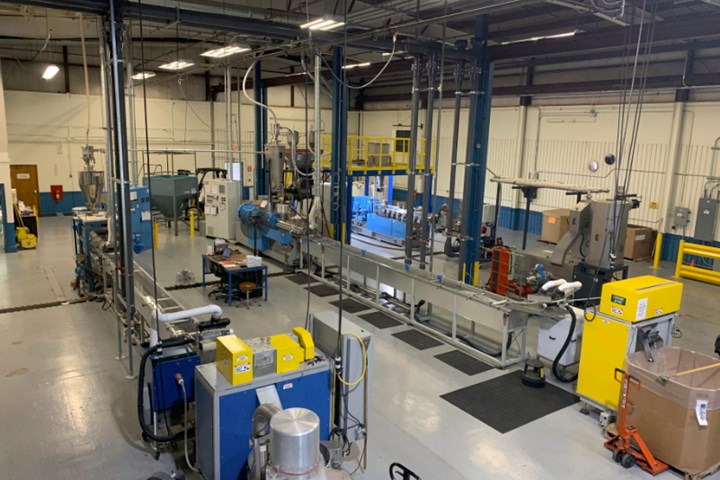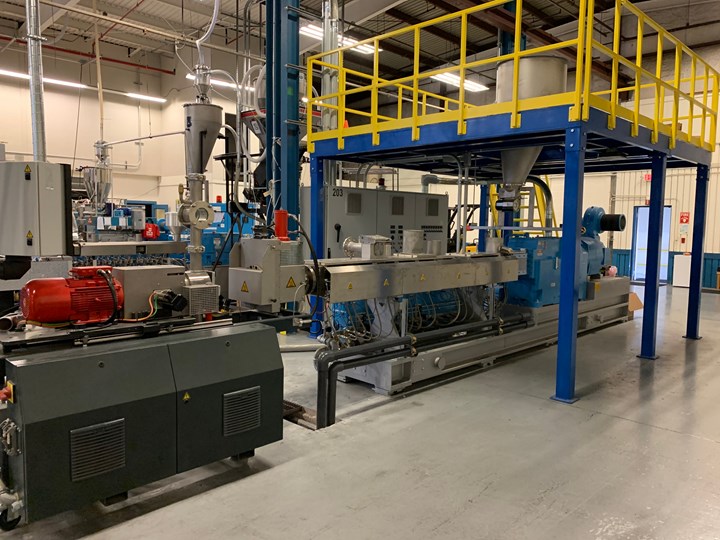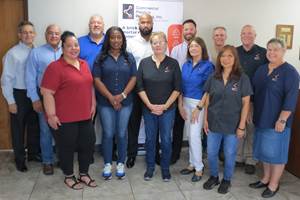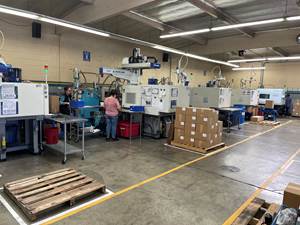The Buck Stops … at This One-Stop Compounder
CRC Polymer Systems brings expertise in material selection, product formulation and processing, and a thorough understanding of part design and tooling under one roof with a series of customized materials and capabilities aimed at OEMs and molders.
When Dave Saldo and Todd Ewing decided to start their own venture in compounding some 20 years ago, they identified a void in the marketplace and endeavored to fill it. They began with how they named their new company: CRC Polymer Systems—for Compounds, Resins and Colors. The two seasoned plastics-industry professionals—Saldo on the technical side and Ewing bringing technical and sales/marketing expertise to the table—witnessed first-hand the changing landscape of the materials market. They saw that many major suppliers were cutting back on technical marketing resources in the areas of material selection, product formulation, processing and understanding part/tooling design. CRC was established to fill that void.
Saldo, who is co-founder, v.p. and technical director of the Sodus, N.Y., firm, traces his roots in polymers to the mid-1970s, when he started in the phenolics business of GE Plastics (now SABIC), in Pittsfield, Mass. He was on the ground floor of the early days of polymer innovation, when the big guys in resins would bring in teams from various technical disciplines—product development, part and tool design, process engineering, and technical support—to OEMs who were beginning to transition from metal and other materials to plastics. Saldo was instrumental in the development of GE’s Heavy Valox PBT resin and capped his career there as an advanced process engineer before being recruited to resin distributor M.A. Hanna Co. (which became PolyOne, now Avient) as its first technical hire.
CRC co-founder Ewing, the firm’s president, started his plastics career at the research labs of Eastman Kodak’s advanced-films division in Rochester, N.Y.He began as a product specialist, then became an account manager, positions that put him in regular contact with compounding companies that provided materials to the film producer. And like his future partner, he found himself recruited by M.A. Hanna to handle sales in the Northeast.

Production lines at CRC’s compounding plant 60,000 ft2 plant in Sodus, N.Y., include 40- and 50-mm Leistritz twins with strand pelletizing.
Recalls Saldo, “Early on in my career we had a targeted team that would work together on projects with OEMs: materials engineers, product engineers, process engineers, marketing managers. It was a lengthy and expensive process, but for large OEM accounts it was necessary and effective.” The idea was to bring together all the links in the product-development chain so that all the voices in the room could be heard before any tool steel was cut.
“We are all about being application-specific: Design the lowest-cost product that can get the job done.”
In time, materials companies started to rely on emerging resin-distribution companies to provide materials to OEMs and molders...but they brought limited technical support, according to CRC. Saldo recalls, “We began conceptualizing CRC in the late 1990s, when we saw a real need in the industry for a material supplier that could supply all material facets (compounds, resins, colors) along with complete technical support—beginning with material input in the design stages of a program through tooling reviews and right on to processing support throughout the life of the program. Todd and I pooled our money and aligned with several suppliers and compounders that we had developed strong relationships with and began supplying resin and producing proprietary products.”
Saldo continues, “CRC’s philosophy and mission statement from 2000 remain the same today: to work with OEMs and captive (and custom) molders putting together the material systems for various applications to achieve the best performance at the best price. We are all about being application-specific: Design the lowest-cost product that can get the job done.”

CRC’s materials development lab includes a 25-mm twin, an 85-ton injection press for molding specimens and running prototype molds for customers, and a range of testing instrumentation.
Adds Ewing, “We have the responsibility and take accountability for all material aspects of the program. We’re providing a complete system of compounds, resins and color. If a customer has a problem running our product or with part performance, they make one call, to CRC. That was our vision when we started our business and it remains so today.”
Everything produced at CRC is designed for optimal part performance at the lowest possible cost. The firm’s two primary end markets are consumer and industrial. Offers Ewing, “We are not a grocery store. We don’t just produce a line of talc-filled PPs or glass-filled nylons, for example. We specifically engineer products to meet application requirements. The orders tend to be higher volume, usually truckload quantities. Our compounds are cost-effective solutions for our customers, who in some cases may be running engineering resins at $5/lb. This concept offers value to both CRC and our customers because it is unique in nature and tailored to very specific needs.”
The process actually begins well before a single pellet is melted. “We really can’t point to a single company as a competitor,” Ewing continues. “I get asked a lot about how we’re different: We sit down with the OEM, molder, and moldmaker and talk about what the application needs. When we look at things like gate location in the tool, for example, we’re coming at it from the point of view of the material. Ultimately the toolmaker may have other ideas, and that leads to a discussion. From there we identify the best material solution and begin manufacturing.”
Ewing adds, “But perhaps the most important aspect of our value proposition is that we routinely go to the customer site and mold product. We don’t just ship the material and ask them, ‘How did it go?’” Dave Saldo is a seasoned technical service engineer; he’ll go and work with the molder to optimize the process for the material. Our customers look at us as a partner and as an extension of their technical resources team.”
Slight Change in Plans
When CRC was launched, it was intended as a marketing company that specialized in developing material solutions. Both Saldo and Ewing agreed the startup would not get into manufacturing. Its launch product was Polycycolate, a PC/polyester alloy, which is made by a proprietary process. “In the early stages, a great deal of our product development was with OEMs we had relationships with,” states Saldo. “We’d get calls from people we knew, telling us, ‘We’re coming out with this product line. We need a certain performance package, but the material costs we’re being quoted are prohibitive. Can you help?’ So, we’d go in with material to support a new program or help redesign a material for an existing program.”
“We routinely go to the customer site and mold product. We don’t just ship the material and ask them, ‘How did it go?’”
CRC leased space in Rochester, N.Y., to compound Polycycolate, but would use outside labs and other resources for further product development. By 2011, though, CRC was concerned about making CRC’s intellectual property vulnerable by using outside services. The company also realized the limitations of outsourcing production.
“We were confined by the technology and equipment available to us at that time. We wanted to try different screw designs, different process techniques, but there is only so much you can do in another company’s facility.” At that point CRC began to look for a 10,000-ft2 pilot plant to handle product development and manufacturing itself.
Unable to find anything suitable, in 2014 CRC bought a 60,000-ft2 manufacturing plant in Sodus, N.Y., on a 3.5-acre site. An additional building nearby accounts for another 5000-6000 ft² of manufacturing space. It expects to have a rail siding in place and active by fall. CRC currently runs 40- and 50-mm corotating twin-screws from Leistritz with strand pelletizing. At press time it was in the final stages of installing a third Leistritz twin—a 75-mm ZSE Maxx with an Econ underwater pelletizer. When operational next month, the third production line will boost the compounder’s capacity from 15 million lb to 35 million lb/yr. At that time, CRC expects to bump its employee count from 13 to 20. Plans are on the horizon to bring on an additional 60-mm Leistritz twin. CRC also recently installed a central chilled-water system from Sterling to meet current and future expansion needs.

At press time, CRC was installing a 75-mm ZSE Maxx Leistritz twin, which will bump its capacity to 35 million lb/yr.
The production floor is supported by a 25-mm twin-screw pilot line for product development and a complete materials-development lab. The lab is equipped with a suite of instrumentation for testing Izod and Gardner impact, heat deflection, flammability, ash content, tensile and flexural modulus, melt-flow index, and moisture content. CRC plans on investing in more rheological testing equipment soon. The lab also has an 85-ton injection press for molding test specimens and running customer prototype tools for product development.
Ewing says CRC’s business has tripled since it opened the Sodus manufacturing plant six years ago. It has kept its core of existing customers but has refined its product line by tailoring formulations to allow it to expand to new customers and applications.
In addition to Polycycolate, CRC has developed and produces a completely BPA-free material called TriFax, a polyester alloy that includes a flame retardant without compromising transparency. It also offers Carbelene, a TPME (thermoplastic mineralized elastomer) aimed at applications currently held by engineering resins.
Says Saldo, “We took a crystalline material, mineralized it, impact-modified it, and got it to shrink isotropically like engineering resins from 0.004 in./in. to 0.010 in./in. in both directions. You don’t have to dry it, it has lower specific gravity and much higher chemical resistance than many engineering resins, along with excellent cold-temperature impact. It’s an ideal replacement for PC alloys. If someone needs engineering properties, we can supply a product that gives them the performance they need that we can produce in large quantities at a price that makes everyone happy.”
Most recently, CRC unveiled Carbelene Clear, available in a press-ready compound or in masterbatch form. “This is the highest-impact clear polyolefin on the market,” Saldo maintains. “Generally, if you want impact in a clarified polyolefin crystalline material, you have to go to very low melt flow—generally 6-10 g/10 min. We’ve created products with melt flows ranging from 30 to 80 g/10 min while providing high ambient and cold-temperature impact and maintaining excellent clarity with low or no blooming. The material has a great balance of performance and processing properties and has really taken off.”
CRC further offers Barkolene, a wood-fiber filled compound that’s available in engineering and commodity resins. It is produced with a variety of different wood fibers, depending on the application. It comes in various grades tailored to meet aesthetic and performance requirements.
“I don’t think we’ve ever lost a piece of business in 20 years because someone else came up with a more cost-effective product.”
In development is a line of biobased materials. Comments Saldo, “From a business standpoint and from a responsibility standpoint, these kinds of materials will be part our future. Like everything else we do, we are approaching this new-product launch from a performance standpoint and will be tailoring the materials to meet the application performance requirements.”
The compounder is also investigating becoming a player in the medical market. “We have a customer base of advanced molders that are strong in medical and we see an opportunity for material development for future product lines in this market,” says Ewing.
Adds Saldo, “Our mission is to deliver and provide our customers with the best-performing products at the best price. If the application looks like it would be best in a mineralized elastomer or olefin-based material, and will perform just as well as an engineering resin, that’s what we target. We do this from the beginning, as all applications ultimately get to this lowest common denominator.
“For instance, an application may start out with a high-cost engineering resin, and as it moves along through its lifecycle some of the criteria that the OEM originally specified doesn’t exist anymore. Because of this approach, I don’t think we’ve ever lost business in 20 years because someone else came up with a more cost-effective solution.”

CRC considers its talented and loyal group of employees a critical component to its success. Pictured here are Harrison Kay, plant engineer (l.); and Tom Fuchs, shift supervisor.
While CRC’s business has been expanding mainly due to technical innovation, the co-owners maintain that a family-type culture encompassing its employees, suppliers and customers has made a significant difference. “Everyone’s input is both welcome and needed to keep our business growing,” states Ewing.
Adds Saldo, “What has happened to CRC was what Todd and I envisioned many years ago. We put a business plan together. Yes, some parts of the original plan have been adjusted over the years, but the game plan came to fruition.”
Related Content
Pyramid’s Relentless Pursuit of Quality
Instilling a culture of quality, and the ability to offer tooling from a sister company, are pushing Pyramid Plastics to new heights.
Read MoreInside the Florida Recycler Gearing Up to Take on Scrap at NPE2024
Hundreds of tons of demonstration products will be created at NPE2024 next spring. Commercial Plastics Recycling strives to recycle all of it.
Read MoreMatrix Tool: Welcome to the Family
In its 50th year, Matrix Tool applies moldmaking and injection molding expertise, plus a long family heritage, to high-precision jobs that many would deem impossible.
Read MoreBack in the Family Business
In its 45th year, Precision Molded Plastics has carved out a technology and market niche, growing not just when opportunities arise but when they make sense, after its leader changed careers to keep the family business from changing hands.
Read MoreRead Next
Why (and What) You Need to Dry
Other than polyolefins, almost every other polymer exhibits some level of polarity and therefore can absorb a certain amount of moisture from the atmosphere. Here’s a look at some of these materials, and what needs to be done to dry them.
Read MoreProcessor Turns to AI to Help Keep Machines Humming
At captive processor McConkey, a new generation of artificial intelligence models, highlighted by ChatGPT, is helping it wade through the shortage of skilled labor and keep its production lines churning out good parts.
Read More.png;maxWidth=970;quality=90)




























